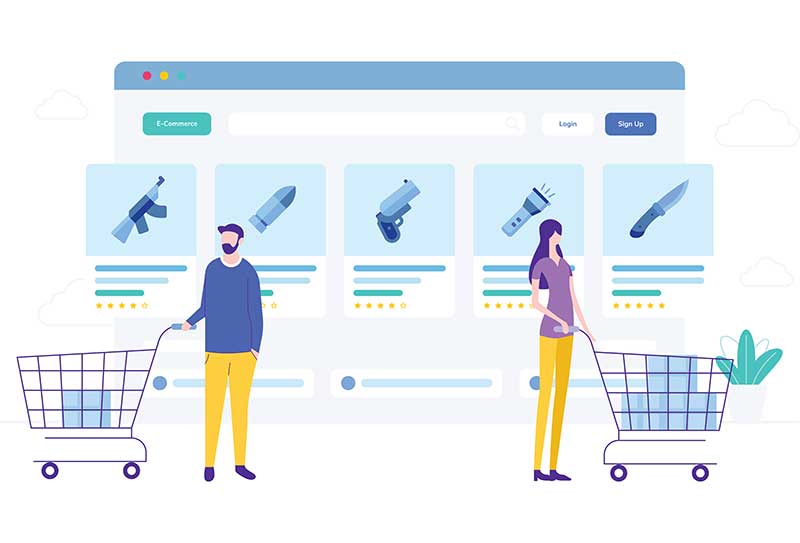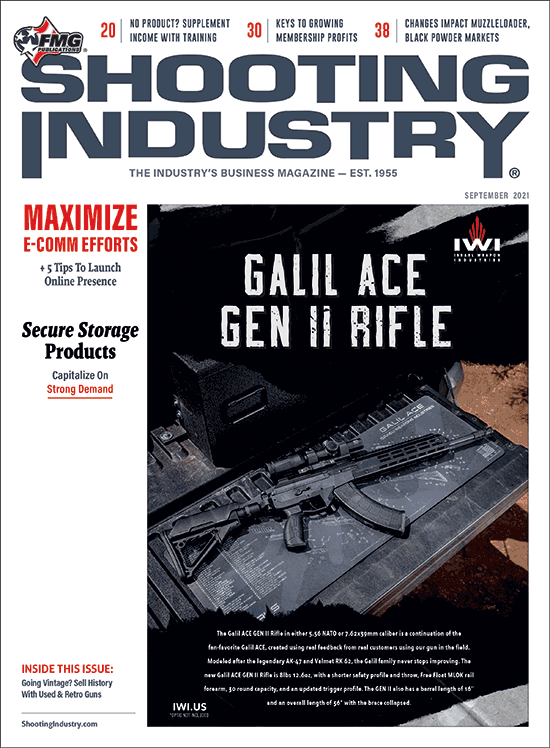Maximize Your
E-Commerce Efforts
There’s no denying it — e-commerce is here to stay. Research conducted prior to 2020 estimated 95% of all retail purchases would occur online by the year 2040. Last year, the COVID-19 pandemic ignited the migration to e-commerce. According to recent data from the U.S. Department of Commerce, online shopping in the United States continues to grow. Retail e-commerce sales in the first quarter of 2021 were up 7.7% from the fourth quarter of 2020. First-quarter 2021 online sales increased an estimated 39.1% over the first quarter of 2020.
While many retailers in the shooting sports industry have found success with online sales, the decision to invest in an e-commerce program isn’t always clear-cut. As we all know, government regulations make selling firearms and ammunition online more difficult than selling other products. Unfortunately, some e-commerce providers refuse to work with FFL dealers. Store owners also have to consider the daily demands and costs of operating in the e-commerce space. Even with the drawbacks, many dealers have decided the benefits outweigh any risks.
To get an inside look at how FFL dealers are maximizing their e-commerce efforts, Shooting Industry spoke with Rex Gore, president/CEO of Black Wing Shooting Center in Delaware, Ohio; Mark Abramson, president of Los Ranchos Gun Shop in Albuquerque, N.M. and Jeff Monroe, president of 22three Inc. in Lebanon, Ohio.
Here are the insights they shared along with several tips and tactics for implementing and managing a successful e-commerce program.
SI: How long have you been selling online?
Monroe: We’ve had an e-store for about 10 years.
Gore: We have had some form of e-commerce for over 15 years.
Abramson: Four years, in one form or another, starting on GunBroker, Gearfire and later Guns.com.
SI: Do you have a dedicated e-commerce website or are you using a marketplace site such as GunBroker?
Abramson: Gearfire is our principal online outlet currently.
Gore: We are currently using Gearfire, and have for five or so years, which is incorporated into our main Black Wing website at BlackWingSC.com. We also use GunBroker at times.
Monroe: We started with a site created specifically for 22three. We designed it to fulfill two primary goals. First, we wanted to provide our brick-and-mortar customers with a live catalog of currently available products. We also wanted to be able to sell beyond our brick-and-mortar limitations geographically and physically. The site did both very well. The e-store business is always changing. With more and more online stores available, we have found the tendency is for online sites to focus too heavily on price. They tend to cause the industry to race to lower margins and less profitability. That’s not our goal. Our goal is to elevate our customer’s experience. We’ve found by focusing on our local customer base, we do better at providing our customers a top-tier experience. In this way, our online presence is a way to increase products available to our local customers. They appreciate the convenience of a larger inventory and being able to shop from home and we can offer free shipping to the store.
SI: What types of products do you sell online?
Gore: We sell everything sporting goods-related carried by our designated distributors.
Abramson: On Gearfire, we’re able to sell anything available through our distributors. We don’t generally carry our in-store inventory online.
Monroe: Selling online helps us offer a wider variety of products than we can in our physical location. Because we don’t have to hold the inventory, we are able to offer customers a much wider array of firearms, ammunition and accessories.
“With more and more online stores available, we have found the tendency is for online sites to focus too heavily on price. They tend to cause the industry to race to lower margins and less profitability. That’s not our goal. Our goal is to elevate our customer’s experience. ”
Jeff Monroe, President • 22three Inc. • Lebanon, Ohio
SI: Describe what it’s like to manage a shooting sports e-commerce site.
Gore: Outside companies like Gearfire make it easy for a dealer to provide e-commerce. It does take some time to get it set up and daily supervision to manage orders. But e-commerce is part of our future (for all retail businesses) and you are missing opportunities if you don’t have it.
Monroe: Be prepared to spend a great deal of time setting up an e-commerce site. For us, it’s important to maintain a consistent brand experience on all of our platforms. In addition to getting the look and feel right, keeping up with the inventory offerings from multiple sources takes quite a bit of time.
Abramson: By keeping our in-store inventory off of the web, we are able to focus our attention on customers who come and shop in our store. Gearfire allows customers to wade through items available in distribution.
SI: How much time does it take to maintain an e-commerce website?
Monroe: The setup of an impactful and profitable e-commerce site takes a great deal of time. While there are plug-and-play options available that would likely require less effort, it takes time for us to differentiate our company from a sea of other online retailers that look and function the same.
Abramson: When we added our in-store inventory, the process of adding product was simple with our POS (point of sale) system. However, we lost track of items sold online we may have been in the process of selling to an in-store customer.
Gore: Depends on the volume of daily sales. The more you sell, the more time it takes to manage. We spend probably a couple of hours per day now, but during COVID, probably four hours per day.
SI: Do you have staff members who are dedicated to e-commerce sales?
Gore: Yes, one of our buyers handles the majority of the orders.
Abramson: No.
Monroe: We have several different staff members involved in maintaining the site and processing online orders. Most of our online sales come to the store and our staff processes them.
SI: Does your staff handle all the shipping tasks?
Gore: At the moment, all sales are to be picked up in our store. We’re looking into shipping and other alternatives now that the industry has cooled down. We do make some exceptions and will ship if requested.
Abramson: We handle shipping internally.
“Your customer satisfaction ratings will depend on your willingness to give refunds and guarantees and the quality of communication. If you offer great customer service in your store, how can you improve the service online?”
Mark Abramson, President • Los Ranchos Gun Shop • Albuquerque, N.M.
SI: In an era of “virtue signaling” from the boardroom, how difficult is it for an FFL dealer to find a good e-commerce partner?
Monroe: There are many e-commerce partner options for firearms dealers. In an era where many mainstream tech companies have signaled their unwillingness to work with the firearms industry, other (typically smaller) companies are eager to fill any gap in services.
Gore: Not sure, as we haven’t been looking, but our industry has very limited sources as a result of what we sell. Gearfire is the best out there and the easiest to manage, in my opinion, if you’re using AXIS retail management software.
Abramson: We’d like the Gearfire platform to be searchable on most search engines. Even when we use Guns.com, people have to go to the site before they can find the gun. Customers often prefer to type in a gun or UPC to locate the firearm. Large online retailers dominate this space currently.
SI: What e-commerce features are the most important for FFL dealers?
Gore: Ease of filling orders due to connections to distribution sources. The ability to set pricing across departments and categories.
Abramson: Being able to search for available product rather than in-store.
SI: What advice would you offer a retailer who is considering developing or revamping an e-commerce website?
Gore: Hire professionals who are experienced in setting up websites and e-commerce in our industry. Find a partner like Gearfire that can plug into your website.
Abramson: Think through the fulfillment side and a commitment to shipping, and expect nuisance phone calls asking all about a particular item while they are shopping. Your customer satisfaction ratings will depend on your willingness to give refunds and guarantees and the quality of communication. Chargebacks on credit transactions will increase significantly, regardless of safeguards. If you offer great customer service in your store, how can you improve the service online?
Monroe: Pay close attention to customer experience. Understand every customer has a sea of options when it comes to online purchases and there must be a differentiator that causes them to choose your e-commerce site. Think of your e-commerce in the same way as your brick-and-mortar location. When you walk into a brick-and-mortar store, there’s always a first reaction you experience. Maybe the reaction is customers immediately feel comfortable or maybe it’s a no-frills utilitarian environment. This is the same for e-commerce sites. Pay close attention to a customer’s first reaction to the online store and make sure it provides them with the experience you want them to have.
5 Tips For Breaking Into E-Commerce:
Are you ready to take a shot at online selling? Here are five tactics to help get you started.
1. Pick Your Platform.
There are more e-commerce solutions available to retailers than ever — which can be confusing. You can go the traditional route of building your own e-commerce website from the ground up.
Hosted e-commerce platforms, such as AmmoReady, Gearfire, Magento and WooCommerce are another popular option. They enable you to quickly and easily set up an online store using pre-built templates and themes. Hosted e-commerce sites are typically less expensive up front, but keep a close eye on any monthly fees the providers may charge.
You can also elect to sell products through marketplace sites such as GunBroker.com. There are benefits to each approach, so you’ll need to determine which better suits your unique needs. Spend some time conducting online research and talk with other FFL retailers who have experience with e-commerce.
“Don’t believe what the sales folks are telling you,” Abramson advised. “Check for yourself. Ask for references from other retailers using the platform, and also those who no longer use it.
2. Consider The Costs Of Shipping.
While some local customers may prefer to pick up their products in person, a significant percentage of online orders will likely require shipping. You’ll need to develop a shipping strategy and policies that work for both you and your customers. Do you plan to ship internationally or only to customers in the U.S.? What should you charge to cover shipping costs? Who will handle order fulfillment? Does your staff have the time to pick and pack all the orders and then ship them? Or should you consider drop shipping? From picking the products to packaging to printing shipping labels, think through every step that goes into shipping products.
Monroe advised being prepared for an influx of returns once your e-commerce store is up and running.
“Consider the downside of returns. If you’re looking at shipping directly to end users, have a plan in place to manage potential returns,” he said. “Customers are very accustomed to easy return processes. We’ve found a higher rate of return requests for goods purchased online. The modern online shopper may have never had the product in their hand and, once they do, they might not like it.”
Preparing before you launch your e-commerce site will help ensure your success. Goal setting is key.
3. Invest In A POS System.
If you haven’t already invested in a point-of-sale system, what are you waiting for? A reputable POS system will help simplify day-to-day tasks and maximize your operation. A POS system that easily integrates with your e-commerce platform will help take the work and worry out of selling online. For example, it will track your inventory and prevent displaying items online as “in stock” when you’re actually sold out.
4. Start With Products You Know.
Retailers sometimes fall into the trap of loading up on the latest “hot products” only to get stuck with them. When it comes to selling online, take the same approach you use for stocking the shelves of your brick-and-mortar store. Start with items you have a history selling. Then you can expand your online offering from there.
An advantage to “stocking what you know”? You won’t unknowingly stock less-durable products for customers, according to Monroe.
“Several of the platforms available feed a distributor’s entire product offering to your website. Because of this, your website may be selling items you would never carry in a brick-and-mortar location,” he cautioned. “We’ve had multiple examples of customers buying very low-quality items that are inevitably going to wear very quickly or not perform up to our standards.”
Monroe shared a fix. “We’ve taken the approach of selecting products we trust for our traditional onsite retail merchandise, and try to show customers there are advantages to sticking with products we know and trust,” he added.
5. Be Prepared For Success.
Whether it’s opening a new brick-and-mortar store or launching an online storefront, always be prepared for it to succeed. Have a plan in place to handle an unexpected rush of orders. Make sure your team is fully prepared for the additional work. Talk to your distributors to ensure the supply chain can handle any increased stress.
Preparing before you launch your e-commerce site will help ensure your success. Goal setting is key.
Abramson concluded: “What is your goal? Increased in-store traffic? Moving stale inventory? Being the next Bud’s? Are you willing to devote a full-time resource to online?”






